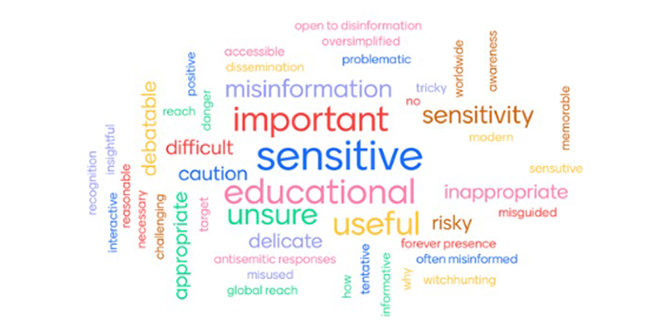
Holocaust Education and Social Media: What Young People Really Think
by Dr Kate Marrison
Dr Marrison reports from a recent event which brought together young people from across the UK to further their understanding of the Holocaust and its contemporary relevance.
We’re familiar with the pros and cons of social media, but what role can it play in Holocaust education, memorialisation and commemoration?
This was the topic of a workshop I ran this month in London with an audience of 30 16-to 25 year olds at the Holocaust Educational Trust’s annual Ambassador Conference (AmCon).
The Ambassadors come from across the UK and from a range of backgrounds. The initiative tasks young people to be ‘the driving force’ behind efforts to make sure that British people understand and remember the Holocaust. Holocaust survivors and other educators were also present.
The workshop explored how museums, memorial sites and professional memory institutions harness social media.
We kicked off with a quiz asking which were the most popular social media platforms they engage with – Instagram, Tiktok and Snapchat – and which three words describe their thoughts about social media being used for Holocaust education.
Attitudes varied from those optimistic about the potential of social media (‘educational’, ‘important’ and ‘useful’), to those who expressed more caution (‘risky’, ‘difficult’, and ‘sensitive’).

A small number felt strongly that incorporating social media into Holocaust education is ‘inappropriate’ and ‘misguided’. One response was simply ‘no’.
We discussed a recent research report from the Landecker Digital Memory Lab which identifies urgent priorities in this area in collaboration with content creators, practitioners, academics, and heritage professionals.
One particular recommendation came to the fore:
Be realistic and self-reflexive about the concerns and challenges of social media – create content that addresses the difficulties faced in doing this work online. Such content may create an open discussion and help change attitudes more widely.
This triggered a fascinating discussion about how content creators can be transparent about the challenges of posting this material on social media.
We explored the Tiktok account of the Neuengamme Concentration Camp Memorial in Hamburg, Germany. They create posts which raise questions like Why are we on Tiktok?, Tiktok to educate? and even What changed for them personally when they started creating TikTok content.
AmCon participants then worked in groups to investigate other examples, including the TikTok account of American singer-songwriter Montana Tucker who created a documentary series How To: Never Forget, partially funded by the Claims Conference. The films were released over 10 days leading up to the Kristallnacht commemoration.
We considered how her videos adopted a broadcast-like logic, rather than TikTok aesthetics and vernaculars. I’ll be publishing further research on this with Dr Victoria Grace Walden soon.
The young people in the room identified that Tucker does not use TikTok features like duets or stitches, lip-synching, dancing, or bluescreen. This goes against the grain of her usual content and, importantly, against her usual strategy to ‘train the algorithm’ as Jones 2023; Siles et al. 2022; Simpson et al. 2022 refer to it.
The group agreed: the docuseries was a thoughtful approach for exploring Tucker’s family history, despite – or because of – the fact it negates TikTok’s formats and even runs the risk of hindering Tucker’s visibility on the platform.
Attitudes varied from those optimistic about the potential of social media to those who felt social media in Holocaust education is ‘inappropriate.’ This begs the question: does it need to be on TikTok at all?
Other participants opted to investigate Holocaust memory and commemoration on Instagram. They homed in on in Eva’s Stories, a private initiative started by Israeli media entrepreneur Mati Kochavi and his daughter Maya in 2019.
Unlike Tucker’s docuseries, Eva’s Stories deliberately adopts the platform’s formats. The project is a fictional Instagram profile portraying the experiences of real-life victim 13year-old Eva Heyman living in Nagyvárad, Hungary in the days before her deportation to Auschwitz.
One group felt the project would have worked better at the time it launched but did not work so well retrospectively, as a kind of ‘archived’ project years later.
Another group were more critical of the project, particularly of the stories in which Eva films herself using her mobile phone. When we delved deeper, they expressed concerns that the actor was attempting to portray the experiences of those who lived through the past, rather than questioning the use of selfie aesthetics as a framing device.
We discussed how these concerns are not unique to social or digital media. In fact, they hark back to debates around the limits of representation in Holocaust cinema (more on that here).
Finally, participants were invited to design their own social media project to mark International Holocaust Memorial Day 2025. One group imagined a cross-platform multimedia campaign which would mark the 80th anniversary of the liberation of Auschwitz-Birkenau through 80 personal objects. This aligns with the International Holocaust Remembrance Alliance’s My Hometown scheme.
More broadly, commemorative plans already include the Association of Jewish Refugees’ (AJR) 80 trees for 80 years initiative and Holocaust Memorial Day Trust will launch a project called 80 candles.
The group plans to develop their ideas from the session further and integrate them into their work as Regional Ambassadors for the Holocaust Education Trust, with a view to inspiring other HET Ambassadors across the country.
Want to know more?
Serious TikTok? Can you learn about the Holocaust in 60 seconds?